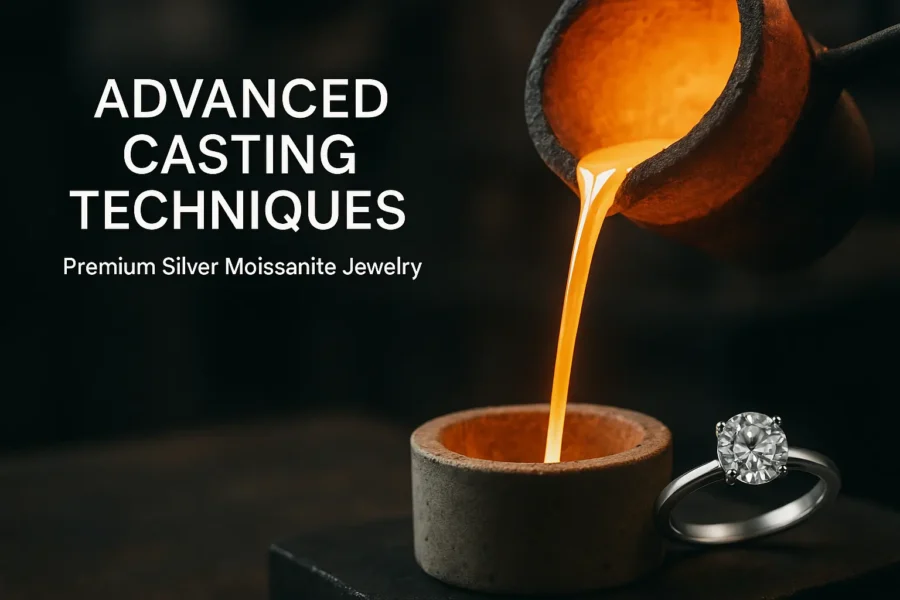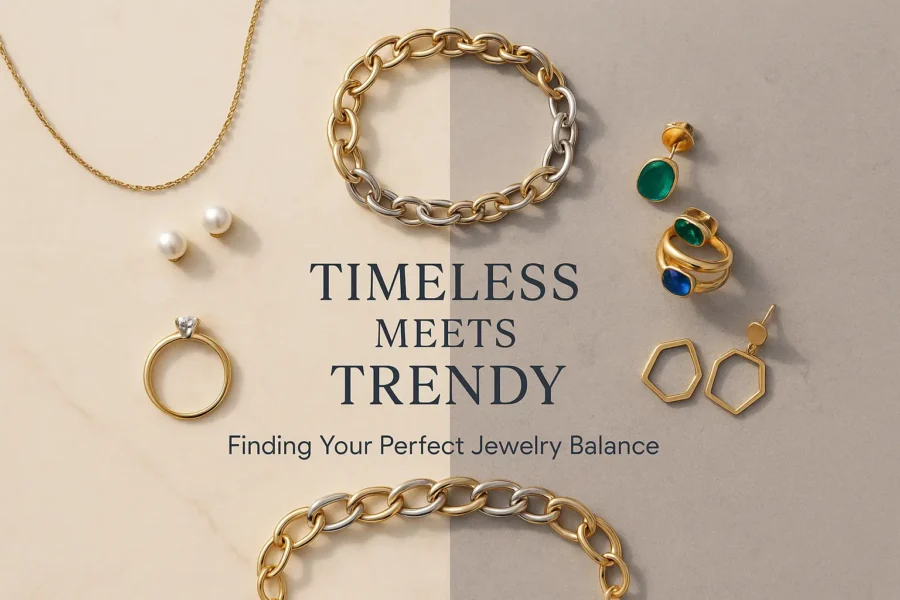What is White Gold: Is It Real Gold?
White gold has become increasingly popular for jewelry, offering the look of platinum for less cost. While some prefer the warm glow of traditional yellow gold, white golds bright white luster has a sophisticated, elegant appeal.
Especially popular for engagement rings and wedding bands, white gold flatters both diamonds and gemstones with its neutral shine. Durable and lustrous when cared for properly, white gold jewelry maintains its fresh look for years to come. For those drawn to its modern aesthetic, white gold is a timeless metal choice to complement any style.
But what is white gold exactly, and is it real gold? In this article, we will answer these questions and more, and help you decide if white gold is the right metal for you.
What is White Gold
White gold is a type of gold alloy, which means it is made by mixing pure gold with other metals. Pure gold, also known as 24-karat gold, is too soft and malleable for jewelry, so it is usually mixed with other metals to make it stronger and more durable.
The metals that are added to pure gold also affect its color, and white gold is created by adding metals that have a whitish or silvery hue, such as nickel, palladium, platinum, or silver.
The percentage of pure gold in white gold varies depending on the karat, which is a measure of the purity of gold. For example, 18-karat white gold contains 75% pure gold and 25% other metals, while 14-karat white gold contains 58.3% pure gold and 41.7% other metals. The higher the karat, the more pure gold and the more expensive the white gold.
Is White Gold Real Gold?
The answer to this question depends on how you define real gold. If you mean pure gold, then no, white gold is not real gold, because it is mixed with other metals. However, if you mean gold that has been mined from the earth and has the same chemical properties as pure gold, then yes, white gold is real gold, because it does contain a significant amount of pure gold.
So, white gold is not pure, but it is real. It is a type of gold alloy that has a different color and appearance than yellow gold, but it still has the value and quality of gold.
How to Tell if White Gold is Real

If you are buying white gold jewelry, you might want to know how to tell if it is real or not. Here are some ways to check the authenticity of white gold:
Doesn’t Tarnish
One of the advantages of white gold is that it does not tarnish or corrode over time, unlike silver or other metals. This is because white gold is coated with a thin layer of rhodium, a rare and expensive metal that has a bright white shine and protects the white gold from oxidation and wear.
If you notice that your white gold jewelry is turning black, brown, or green, it might be a sign that it is not real white gold, or that the rhodium plating has worn off and needs to be reapplied.
Shows Yellow Tinges
Another way to tell if white gold is real is to look for yellow tinges in the metal. As we mentioned earlier, white gold is made by mixing pure gold with other metals, and pure gold has a yellow color. Therefore, white gold is not completely white, but rather has a slight yellowish hue. This is especially noticeable in higher karat white gold, which has more pure gold content.
If your white gold jewelry is completely white, it might be a sign that it is not real white gold, or that it has a thick layer of rhodium plating that masks the natural color of the metal.
Comes with Karat Stamps
One of the easiest ways to tell if white gold is real is to look for the karat stamp on the jewelry. The karat stamp indicates the percentage of pure gold in the metal, and it is usually engraved on the inside of the ring, the clasp of the necklace, or the post of the earring.
For example, a stamp of 18K, 18KT, or 750 means that the white gold is 18 karat, or 75% pure gold. A stamp of 14K, 14KT, or 585 means that the white gold is 14 karat, or 58.3% pure gold. A stamp of 10K, 10KT, or 417 means that the white gold is 10 karat, or 41.7% pure gold.
If your white gold jewelry does not have a karat stamp, it might be a sign that it is not real white gold, or that it is a low-quality or counterfeit product. However, keep in mind that some white gold jewelry might not have a karat stamp for various reasons, such as being handmade, vintage, or custom-made. In that case, you might need to use other methods to verify the authenticity of the white gold, such as taking it to a jeweler or testing it with a magnet or acid.
White Gold vs. Yellow Gold

White gold and yellow gold are both popular choices for jewelry, but they have some differences that you might want to consider before buying. Here are some of the main factors that distinguish white gold from yellow gold:
Look
The most obvious difference between white gold and yellow gold is their look. White gold has a white or silvery color, while yellow gold has a yellow or golden color, is often preferred for its modern and elegant appearance, while yellow gold is often preferred for its classic and warm appearance. White gold also tends to match better with different skin tones and outfits, while yellow gold might clash with some colors and styles.
Weight
Another difference between white gold and yellow gold is their weight. White gold is usually heavier than yellow gold because it is mixed with denser metals, such as nickel, palladium, or platinum. The weight of the jewelry might affect how comfortable it feels on your finger, neck, or ear, and how durable it is against scratches and dents.
Durability
Speaking of durability, white gold and yellow gold also have different levels of strength and resistance. White gold is usually stronger and harder than yellow gold, because it is mixed with harder metals, such as nickel, palladium, or platinum. This makes white gold more suitable for holding diamonds and other gemstones and for everyday wear and tear.
However, white gold also requires more maintenance than yellow gold, because it needs to be re-plated with rhodium every few years to keep its white shine and prevent discoloration.
Price
Another factor that might influence your choice between white gold and yellow gold is their price. The price of gold jewelry depends on several factors, such as the karat, the design, the brand, and the market value of gold.
In general, white gold is more expensive than yellow gold, because it is mixed with more expensive metals, such as nickel, palladium, or platinum, and because it needs to be coated with rhodium, which is also very expensive. However, the price difference between white gold and yellow gold is not very significant, and you can find affordable and high-quality options for both types of gold.
Hypoallergenic Properties
One last difference between white gold and yellow gold that you might want to consider is their hypoallergenic properties. Some people might have allergic reactions to certain metals, such as nickel, which can cause skin irritation, itching, or rash.
White gold often contains nickel, which is used to make the gold harder and whiter, while yellow gold usually does not contain nickel, or contains very little of it. Therefore, if you have a nickel allergy, you might want to avoid white gold or choose a white gold alloy that does not contain nickel, such as palladium white gold or platinum white gold.
Conclusion
So in summary, white gold gives you the elegant look of platinum without the super high price tag. Even though it’s not pure gold, white gold does have real gold in it – it’s mixed with some other metals to make it more durable and give it that bright white color.
The popularity of white gold for things like engagement rings shows that people really like its classy yet modern vibe. It also matches both warm and cool skin tones easily and makes diamonds and gems pop.
With white gold, you do have to get it re-plated every so often to keep it looking shiny and new. And some people may be allergic to certain metals like nickel used in white gold alloys.
Compared to old-school yellow gold, white gold has some clear differences in appearance, weight, strength, cost, and allergy-friendliness that are worth thinking about. It all comes down to personal taste and what you’re looking for.
So when you’re picking between white or yellow gold, understanding the pros and cons just helps you find the right fit for your style, comfort, and budget. White gold brings a fresh take to jewelry with its mix of tradition and modern vibe. For many, it’s the perfect balance of classic and contemporary beauty.
Final Thoughts
Boost your business with MinyeJwelry. We are committed to being the largest jewelry store. Whether you need customized or ready-made products, we have our own designers cunban link chains, rings, bracelets styles. A variety of styles to choose from, become a partner with MinyeJwelry and create wealth together






